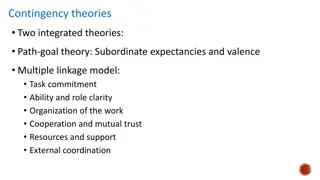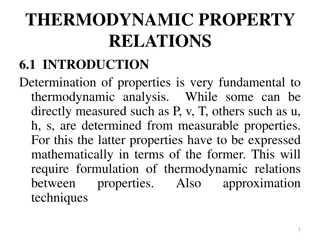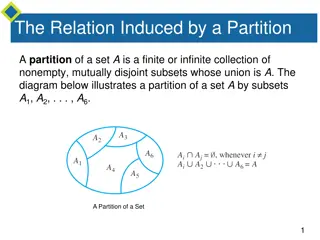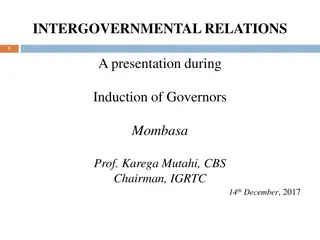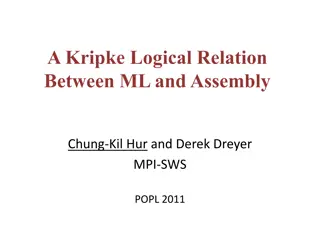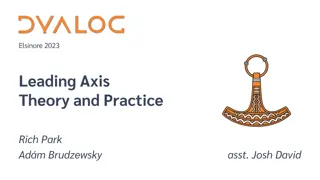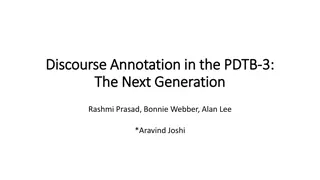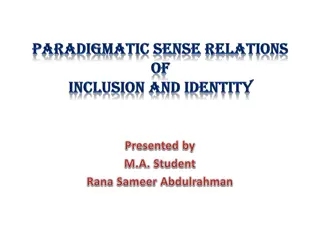
Dyadic Relations, Attributions, and Followership in Leadership
Explore the dynamics of dyadic relations between leaders and followers, the attributions theory, and the leader-member exchange theory. Learn how leaders vary their behaviors with different subordinates and the impact on follower relationships.
Download Presentation

Please find below an Image/Link to download the presentation.
The content on the website is provided AS IS for your information and personal use only. It may not be sold, licensed, or shared on other websites without obtaining consent from the author. If you encounter any issues during the download, it is possible that the publisher has removed the file from their server.
You are allowed to download the files provided on this website for personal or commercial use, subject to the condition that they are used lawfully. All files are the property of their respective owners.
The content on the website is provided AS IS for your information and personal use only. It may not be sold, licensed, or shared on other websites without obtaining consent from the author.
E N D
Presentation Transcript
DYADIC RELATIONS, ATTRIBUTIONS, AND FOLLOWERSHIP
HUBUNGAN DIADIK (DYADIC RELATIONS)?
DYADIC RELATIONS Hubungan individual yang berlangsung secara timbal balik antara pemimpin dan pengikut masing- masing unit kerja.
DYADIC RELATIONS Most of the early theory and research on leadership behavior did not consider how much leaders vary their behavior with different subordinates ...dyadic relationships are not identical for all of a leader s direct subordinates
LEADER-MEMBER EXCHANGE THEORY Pemimpin mengembangkan hubungan timbal balik yang terpisah dengan setiap bawahan sebagai 2 pihak yang saling menentukan peran dari bawahan.
LEADER-MEMBER EXCHANGE THEORY High- Exchange Relationship Low- Exchange Relationship
LEADER-MEMBER EXCHANGE THEORY High-Exchange Relationship Terjadi pada sejumlah bawahan-bawahan yang dipercaya dan biasanya tidak terlalu banyak ingroup Pemimpin mengendalikan hasil akhir/hasil kerja yang diinginkan dari bawahan tersebut benefit : bukti komitmen.
LEADER-MEMBER EXCHANGE THEORY Low-Exchange Relationship Hubungan yang memiliki tingkat saling mempengaruhi yang relatif lemah outgroup Bergantung pada formal role requirements : tugas, aturan, SOP, gaji.
REVISION of LEADER-MEMBER EXCHANGE THEORY INITIAL TESTING PHASE LIFE CYCLE MODE THIRD STAGE SECOND STAGE
ATTRIBUTIONS THEORY Proses kognitif yang digunakan oleh pemimpin untuk menentukan alasan apakah kinerja bawahannya efektif dan menentukan reaksi yang tepat
ATTRIBUTIONS THEORY AT Menggambarkan reaksi manager terhadap poor performance yang ditampilkan karyawan 2 Stage Attribution Model 1st. Tentukan penyebab poor performance (internal atau eksternal) 2nd. Memilih respon yang tepat untuk mengtasi masalah
Two-Stage Attribution Model Managers attribute the major cause of poor performance either to something internal to the subordinate (e.g., lack of effort or ability) or to external problems beyond the subordinate s control (e.g., the task had inherent obstacles, resources were inadequate, information was insufficient, other people failed to provide necessary support, or it was just plain bad luck)
Two-Stage Attribution Model The type of attribution made by a manager influences the response to the problem
Two-Stage Attribution Model Merubah keadaan : menyediakan sumber daya, menyediakan informasi, dll External Attribution Manager s response Memberikan instruksi lebih detil, lebih ketat mengawasi, coaching, punishment Internal Attribution
Research on Attributions & LMX Leaders appear to be less critical in evaluating the performance of subordinates with whom they have established a high-exchange relationship (Duarte, Goodson, & Klich, 1994; Heneman, Greenberger, & Anonyuo, 1989)
Research on Attributions & LMX In contrast, poor performance is attributed to external causes for a high-exchange member and to internal causes for a low-exchange member BIAS
FOLLOWER ATTRIBUTIONS ABOUT LEADERS Ada beberapa faktor yang saling mempengaruhi bagaimana bawahan menilai efektifitas pemimpin
FOLLOWER ATTRIBUTIONS ABOUT LEADERS Mampu menjelaskan alasan perubahan yang terjadi Pemipin akan lebih dinilai positif jika : Lebih memperhatikan anggota dan tujuan bersama Mengambil aksi langsung/ cepat tanggap Berani mengambil keputusan yang inovatif
IMPRESSION MANAGEMENT Proses mempengaruhi persepsi orang lain mengenai diri kita
4 Impression Management Tactics Exemplification Meliputi perilaku yang ditujukan untuk memperlihatkan dedikasi dan loyalitas terhadap tujuan, organisasi atau anggota. Ingratiation Meliputi perilaku yang ditujukan untuk mempengaruhi idv yang ditargetkan agar menyukai seseorang.
4 Impression Management Tactics Self-promotion Meliputi perilaku yang ditujukan untuk mempengaruhi kesan positif mengenai kompetensi kita. Intimidation Meliputi perilaku yang ditujukan untuk mempengaruhi persepsi idv yang ditargetkan agar menganggap seseorang berbahaya.
SELF-MANAGEMENT Seperangkat strategi yang digunakan seseorang untuk mempengaruhi dan meningktakan perilakunya sendiri
DISCUSSION 1. Briefly explain LMX theory? 2. What are some possible benefits and costs of developing different exchange relationships with different subordinates? 3. Is it possible to develop different dyadic relationships with individual subordinates and still treat everyone fairly? 4. Use attribution theory to explain how leaders interpret the reason for poor performance by a subordinate. 5. How can subordinates influence a leader s perceptions about them? 6. Describe the strategies for behavioral and cognitive self-management?

